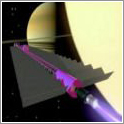Nuclear Fusion Propulsion Systems

The exploration of the solar system requires advanced propulsion techniques capable of specific impulse above 104s and specific power in the range 1-10kW/kg. Fusion is the most interesting option to meet these requirements. Generic fusion propulsion studies, show that specific power values in the desired range are indeed feasible provided a high fraction of the fusion power can be used for direct thrust. Open magnetic field configurations are particularly suited to such purpose.
Open magnetic confinement fusion for space propulsion
In an effort to address the current limitations, in terms of mission capability, of today's propulsion technologies there is a great deal of work being performed both in Europe and around the world on alternative methods of propulsion. One concept which is still at a relatively early stage of development is the direct use of energy from fusion reactions to drive a spacecraft. Theoretical research in this field has been performed for many decades, focusing on a variety of aspects of fusion propulsion from the detailed investigation of fusion reactions themselves to the consideration of the mission characteristics of a constant thrust fusion vehicle. Only relatively recently however has work begun to focus on the detailed design of a space-propulsion-specific reactor and the impact of these designs on the potential performance and mission capability of such engines.
Some evaluation work has been performed at a variety of different levels into concepts which employ closed chamber, toroidal confinement reactors (such as those favoured for terrestrial fusion applications), open confinement systems and inertial confinement devices. These studies have been able to draw upon the growing base of practical experience with toroidal reactors and the more recent experimental work into the behaviour of plasmas in open confinement systems e.g. gas dynamic mirror (GDM), field reversed configuration (FRC). The preliminary results of this work have shown that open magnetic configurations have a number of advantages in terms of their use in space, and as such some engineering design approaches (e.g. Integrated Design Environment Algorithms) have been developed to gain a more comprehensive understanding of the behaviour and performance of these devices.
ACT Research
In collaboration with European academia, the ACT is conducting a study on the feasibility of open magnetic confinement fusion propulsion. The main objectives of this study are:
- To evaluate the current status of practical research into fusion confinement systems, specifically open magnetic configurations, and identify new concepts where possible.
- To investigate the feasibility of open magnetic fusion systems for space propulsion (particularly GDM with embedded field reversed configuration), including the study of the main physics and engineering challenges associated with achieving self-sustaining fusion processes.
- To consider possible solutions, experiments, and technology developments needed to overcome these challenges.
- To outline a plan of focused research and experimental work that could be carried out in Europe in the context of international collaboration.
References
- Carpenter, S.A., Brennan, K.M. and Gatti, R.C., (1998c), "Fourth Design Principle for Application of Fusion Power to Space Propulsion", Cleveland, Ohio, July 13-15 1998, AIAA-98-3593.
- Slough, J., (2001), "Performance Capability and Mission Analysis for a Pulsed High Density FRC Fusion Rocket", Salt Lake City, Utah, July 8-11 2001, AIAA-2001-3674.
- Kammash, T. and Lee, M., (1995), "Gasdynamic Fusion Propulsion System for Space Exploration", in: Journal of Propulsion and Power, Vol. 11 (3) 1995, pp.544-553.